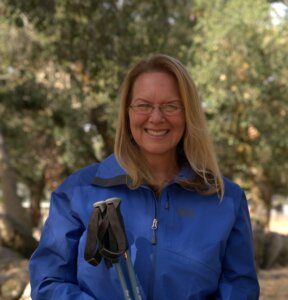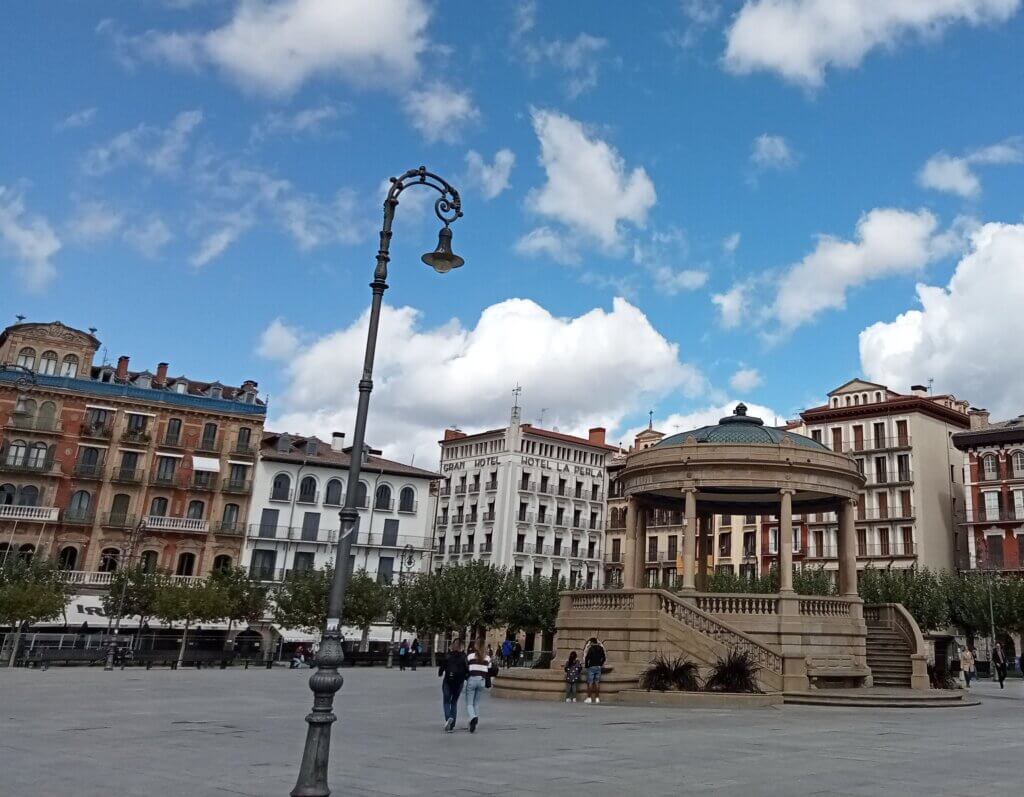It’s no secret: I am a big fan of the Spanish-Basque city of Pamplona.
I think I can even call it a long-term relationship. Pamplona and I go waaaay back. I started my first pilgrimage on the Camino Francés in Pamplona, on September 13, 2005. Then over the past nearly 20 years I have visited this beautiful city so many times I wouldn’t even be able to count.
There I am, first day on the trail:
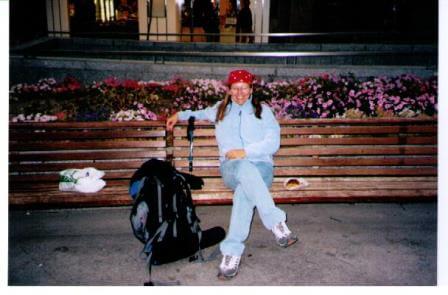
I spend time in Pamplona every time I am in Spain, whether I am leading a group on the Camino or not. I love it that much.
All of my Camino Experience groups pass through Pamplona, and many of my pilgrims take a rest day there. I love it when they ask me if they should plan a rest day in Pamplona. My immediate answer is YES! But of course, then I have to tell them why.
Here are my top five reasons for taking an extra day in Pamplona:
1. Catch your breath after a whirlwind start
Starting the Camino Francés often happens in a flourish, in a big wave of anticipation and excitement as pilgrims jump into the flow of the Camino.
You arrive in Saint Jean Pied de Port, queue up at the Pilgrim’s Office for your Credencial and first stamp, check in at your gite, refuge, guesthouse, or hotel, fuss with your things, grab a meal, and then race out of town first thing in the morning.
Whoooosh.
While in Saint Jean Pied de Port and as you make your way up and over the mountain, you are meeting people from all over the world and having conversations in half-languages as you climb climb climb. The weather is either gorgeous or terrible and you may or may not get a chance to sit down for a proper break. You might have sufficient food for the first day or two, or you might be powering over the mountain fueled only by toast.
After a steep descent into Roncesvalles, you grab a shower and a meal and collapse into your bed, in anticipation of the next day’s walk.
New languages. New people. New food. New experiences, sights, sounds, and smells.
You find yourself asking questions you have never asked before. How do I make this shower work? Where did I put my wallet? Did I leave my phone cable in Saint Jean???
After approximately 66 kilometers you arrive in Pamplona, and you may be wondering, what just happened?!?!
This is the number one reason I recommend pilgrims take a rest day in Pamplona, so their thoughts and emotions can catch up with their bodies.
I suggest you drop your backpack or luggage and stay in the same place for two nights. Rest and try to relax.
Unpack everything and evaluate – what do you really need? Which items in your pack are you using every day, and which ones are just taking up space and weighing you down?
Repack and put things where you can reach them easily. Now that you have three or four days on the trail under your belt, you know what you need when. You know what should be easily accessible and what can be buried in your pack.
By Pamplona you also know how your gear is working out, and you know if you are missing anything important. Which brings us to the next reason to take a rest day in Pamplona.
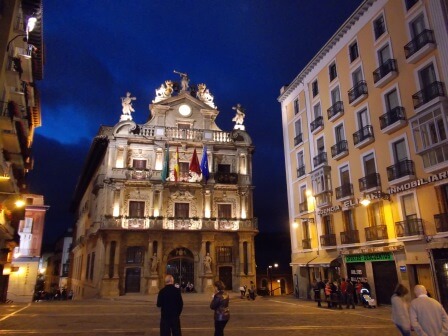
2. Make time for an errand day
The best (in my opinion) gear shop on the Camino Francés is located in Pamplona. It’s called Caminoteca and it’s run by two Hungarian pilgrims – Istvan and Anita – who know what you need. Their entire inventory is curated for pilgrims, and their shop is located just steps away from the Camino trail as it makes its way through the historic city center of Pamplona.
If you need it, they have it. If they don’t have it, you don’t need it.
That’s errand #1, to buy any gear you need or replace gear that’s not working. (Pro tip: be sure to have some room in your budget for gear mishaps and missteps. Most pilgrims don’t get all their gear just right on their first pilgrimage.)
Errand #2 – if needed – is to visit the post office, or Correos, to send home or ahead to Santiago any items that you now know you don’t need and therefore don’t want to carry all the way across Spain. The Correos office in Pamplona is located just steps away from the Plaza del Castillo, which is the main square of the historic city center.
You can send an entire piece of luggage using Correos, or you can buy a box and send a bag-full of unwanted stuff. And you can send it to your home or to Santiago for pick up when you finish your pilgrimage. There are two solid choices for storing sent items in Santiago: Casa Ivar, who holds items for a fee, and the Correos office near the Cathedral in Santiago. If you send your items to the Correos office, the cost of storage is included in the shipping fee.
Errand #3 is to do a load of laundry. There are three laundromats, or lavanderías in the center of Pamplona. For around five euros you can get your dirty, smelly pilgrim clothes back to a nice, fresh state, and for a few euros more you can dry them completely in a giant commercial tumble dryer.
The lavanderías have two sizes of washing machines. If you are on your own, hopefully you will catch the smaller one open and available. If you are traveling with someone or with a group, you may want to team up for a load in the larger, eight-ish euro machine.
Here is where you find the lavanderías:
Errand #4 isn’t for everyone; it is only for those who want to get a Spanish SIM card for their smartphone, to allow them to easily make phone calls and have data access all along the way without having to rely on WiFi or an expensive international phone plan from their home country.
Prepaid phone plans in Spain are inexpensive and come with everything a pilgrim needs. For example, my plan gives me 50 gigs of data and 800 minutes of international and within-Spain phone calls for four weeks for just €15. That’s with Orange, and there is an Orange store in Pamplona, just a few minutes’ walk from Plaza del Castillo. Hopefully you will catch one of the English-speaking staff members.
To get a Spanish SIM you will need your passport and an unlocked smartphone.
Once your errands are done, it’s time to go all in on the next reason to take a rest day in Pamplona: to eat.
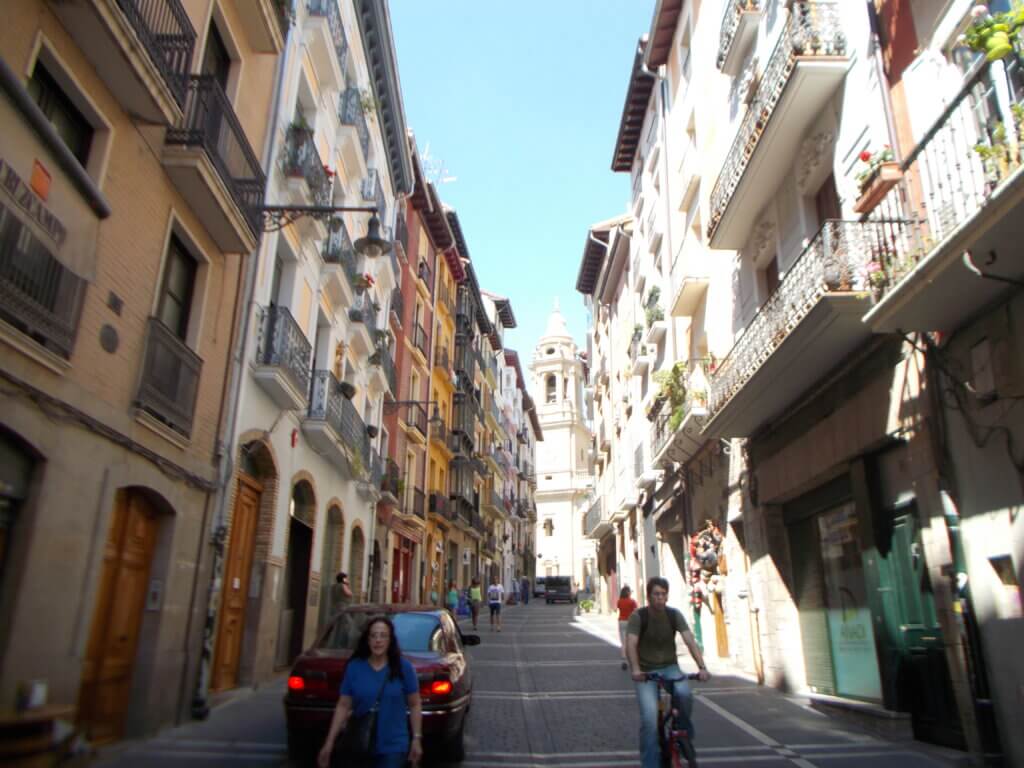
3. Eat your way through Pamplona
There are several cities along the Camino Francés that do food – specifically tapas – really well, and Pamplona is the first one you come to. Although in Pamplona, you will be eating pintxos rather than tapas. Pintxo is a Basque word, and it refers to small snacks that are served on a skewer or toothpick. At least that’s the original interpretation; in reality, pintxos have become somewhat of an art in Pamplona.
To discover the pintxos culture in Pamplona, take a stroll through the historic center of the city any evening starting around 7:00 PM and you will discover all kinds of tasty options. My favorite streets to wander around for pintxos are Calle San Nicolás and Calle de la Estafeta. Simply duck into a bar, check out what’s on offer, catch the eye of the person behind the bar, and point to what you want to try.
By the way, the other cities to pause in for tapas are Logroño, León, Burgos, and of course Santiago at the end.
In addition to pintxos, there are plenty of excellent meals in Pamplona, found at the Michelin-starred Restaurante Europa, the upscale Verduarte where the chef works magic with local produce, and the more humble but fabulous Herriko Taberna. Reservations required for all of these.
This just scratches the surface, by the way. Wander down any street in the historic city center and you are bound to find something good to eat as well as numerous bars and cafés to pass some time in (don’t miss the beautiful Café Iruña, which was the haunt of American author Ernest Hemingway).
In addition to great food, Pamplona also has lots to offer from a cultural perspective, which brings me to the next reason to pause for a bit in Pamplona.

4. Soak in the culture and ambiance
You may know of Pamplona by its reputation of hosting the Running of the Bulls and San Fermín festivals, which are held annually in July. But did you know that you can walk along the bull-run route and tour the bull ring? I am not an advocate for bull fighting or running with bulls, but the history and culture of this event is undeniable.
Pamplona is also home to a gorgeous Cathedral, the stately Citadel, lively pedestrian-only streets, beautiful architecture, and numerous parks. The five-kilometer-long city walls hint at an interesting history, which you can learn more about at the Museo de Navarra. There is also a Camino interpretive center, located on Calle Mayor (which has been the main street of the city since the 1400s).
An extra day in Pamplona allows you to settle into the rhythm of the city and join the locals as they do their shopping in the morning, eat a big lunch around 2:30 PM, and then head to the plazas around 5:00 PM to play (the kids) and socialize (the adults).
In other words: slow down, rest, enjoy. Which many pilgrims need, and which brings me to the final reason I recommend a rest day in Pamplona
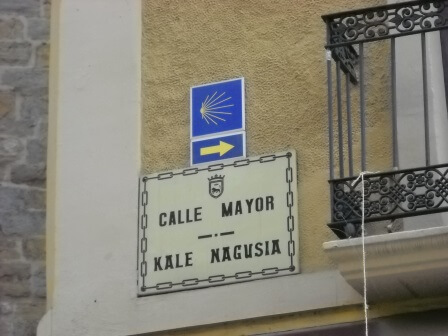
5. Recover from the physical toll of the first few days on the trail
One of the most frequently asked questions about the Camino Francés is how hard is it, really?, referring to the first day or two crossing the Pyrenees.
How hard is that climb? Well, they answer often depends on when you ask someone. If you ask a pilgrim when he or she is in Santiago, at the end of their pilgrimage, it’s likely the answer would be quite different than if you asked the question when they were in Roncesvalles or Pamplona.
I will be frank with you: the walk over the Pyrenees is hard. The ascent is relentless and, in some places, quite steep. The descent into Roncesvalles varies from steep to very steep, and it comes when you are tired and your feet, knees, and hips are sore.
But you recover. You get a good meal in the evening to refuel your body. You spend eight to 10 hours in bed in Roncesvalles (or the next village), resting your body and hopefully getting some sleep.
Ah but then you walk two more days to get to Pamplona, and those days are filled with more ups and downs, with varied – and sometimes treacherous – terrain. Maybe you are sleeping well, maybe not. Maybe you are finding good, healthy meals to fuel the physical exertion, but maybe you are still trying to work out when to get food and how to adapt to a different diet.
The result: by the time you reach Pamplona, many pilgrims have taken on the cumulative effects of three to four days of strenuous walking coupled with jet lag and lack of sleep, and they are flat out tired.
The solution: a rest day in Pamplona. To slow down, relax, rest, eat incredibly well, repack, regroup, adjust, lighten the load, and allow the thoughts and emotions to catch up to the body.
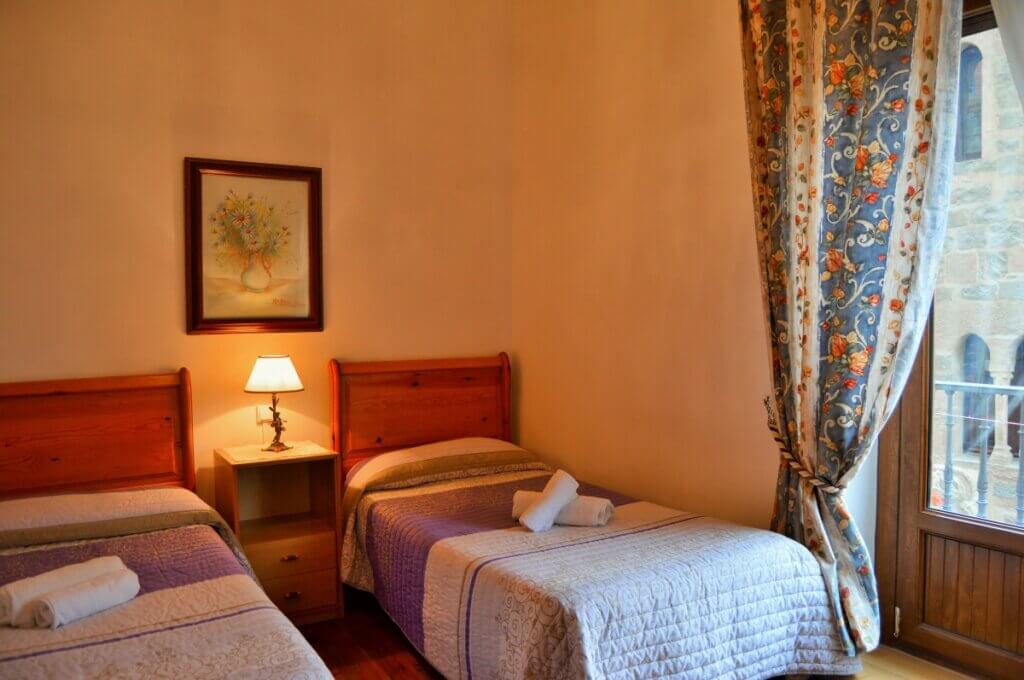
Why people don’t take a rest day in Pamplona
With all this going for it, why don’t pilgrims take a rest day in beautiful Pamplona?
I can think of two reasons.
One, pilgrims don’t plan for a rest day in Pamplona because they feel they don’t have the time for it. When you plan out your big-picture itinerary and count how many days you have for the entire pilgrimage, adding in walking days, rest days, and travel days, you may think you don’t have time for an extra rest day in Pamplona.
Two, many pilgrims also don’t think they are going to need a rest day in Pamplona. It’s too soon. They will be only three or four days into the walk, and they want to save their rest days until farther down the trail, when they will need it more.
But here’s the thing: if you don’t take a rest day in Pamplona, your body may force you to take one soon after. And when you walk in and through Pamplona without a rest day in the plan, I bet you are going to wish you had more time there.
Why not plan for it and get the added bonus of more time in this wonderful Spanish-Basque-Camino city? You won’t regret it!
Join me in Pamplona? Join one of my Camino Experience groups and I will show you around in person!
